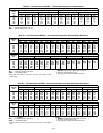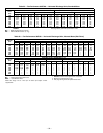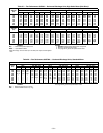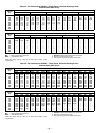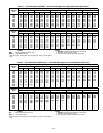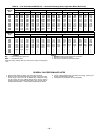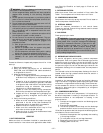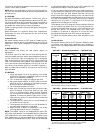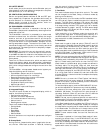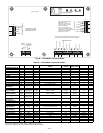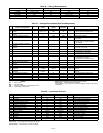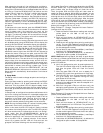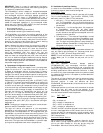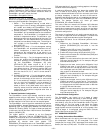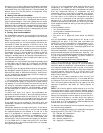—39—
XII. SAFETY RELIEF
A soft solder joint at the suction service Schrader port pro-
vides pressure relief under abnormal temperature and pres-
sure conditions (i.e., fire in building).
XIII. VENTILATION (CONTINUOUS FAN)
Set fan and system selector switches at ON and OFF posi-
tions, respectively. Evaporator fan operates continuously to
provide constant air circulation. When the evaporator-fan
selector switch is turned to the OFF position, there is a
30-second delay before the fan turns off.
XIV. ECONOMI$ER+ CONTROLLER
The EconoMi$er+ controller is mounted to the top of the
EconoMi$er+ damper and is accessible by removing the filter
access door of the unit.
The EconoMi$er+ controller is protected by a sheet metal
enclosure mounted over the controller. Remove the single
screw on the front of the enclosure and lift off the top for
access to the controller. The primary purpose of the controller
is to provide control of the EconoMi$er+ dampers and the
cooling compression stages. The status of the indoor fan is
monitored through the G input but is not directly controlled
by the controller. The heating function is completely indepen-
dent of the controller.
IMPORTANT: The controller can only be used with conven-
tional thermostats with Y1, Y2 and G input to the controller;
it can NOT be used with electronic thermostats with a pro-
portional room temperature input, or with Variable Air Vol-
ume systems.
There are 4 LEDs on the controller, which are used to read
values and display status and configuration information.
There are 2 buttons (READ/ADJUST and ADVANCE/ MAN-
UAL), which change modes and configure the controller. See
Fig. 36.
The EconoMi$er+ microprocessor based control system pro-
vides the following control functions:
• EconoMi$er+ damper control for free cooling
• Minimum position control for ventilation
• Demand Ventilation Control using a CO
2
sensor
• Compressor Cooling Stage Control
• Occupied/Unoccupied Control
• Diagnostics Display and History
• Manual test control
See Table 35 for Inputs and Outputs.
A. Integrated Display
The control board includes an integrated display, which is
used for the following functions:
•Configuration and setup
• Set point and control adjustment
• Error status and alarm monitoring
• Manual control
• Reading sensor values
There are 5 modes of display operation:
•Startup Mode
•Run Mode
• Read Mode
•Setup Mode
• Manual Mode
External devices are not required to operate and configure
the control.
B. Startup Mode
During the first 3 seconds after power is applied to the con-
trol, the four LEDs flash as shown in Table 36, indicating
that the control is being initialized. The buttons are not
operational during Startup mode.
C. Run Mode
Run mode indicates status of controller and unit. The mode
can be changed to the Read, Setup, or Manual modes by
pushing various buttons.
While the control is in Run mode, the DS1 heartbeat indica-
tor LED (red) will flash to indicate the controller is operating
properly. The DS2 Econo indicator LED (yellow) will flash
whenever economizer is being used for free cooling. The DS3
first stage cooling indicator LED (green) will be on steady
indicate demand for stage 1 cooling. The DS4 second stage
cooling indicator LED (green) will be on steady to indicate
demand for stage 2 cooling.
If the controller is in a different mode, the controller will
return to Run mode after 10 minutes of user inactivity or if
the READ/ADJUST (#1) and ADVANCE/MANUAL (#2) but-
tons are held for at least 3 seconds until all LEDs flash.
D. Read Mode
Read mode is used to check set points (Table 37) and I/O
channel status (Table 38). Enter the Read mode by pushing
and releasing the READ/ADJUST (#1) button. A user can
only enter Read mode from the Run mode (to get to Run
mode, press both the #1 and #2 buttons for at least 3 seconds
until all LEDs flash). In Read mode, LEDs are not lit until
the READ/ADJUST button (#1) is pushed.
NOTE: If the user pushes and holds the READ/ADJUST but-
ton (#1) for more than 3 seconds, then the control will go into
the Setup mode, indicated by the yellow LED (on steady).
While in Read mode, push button #1 then the DS1 LED
(Red) flashes to indicate setup point number as defined in
the setup table. The two green LEDs will then show the
value of the display item. The DS3 LED will first display the
tens digit and the DS4 LED will then display the ones digit.
For example to display 54, the DS3 LED will flash 1 group of
5 at a high flash rate to indicate 50, and then follow with
4 flashes (DS4) at 1-second intervals to complete the display
of the number 54.
NOTE: Do not try to count the “5 Fast Flashes” individually,
but instead count how many groups of 5 flashes were dis-
played. In this case, 1 group of 5 flashes, plus the 4 flashes at
1 second results in the value of 54.
To read the display again, push the READ/ADJUST (#1) but-
ton and the sequence will repeat as many times as needed.
To advance to the next setup point, push the ADVANCE/
MANUAL (#2) button. The controller will cycle through all
the setup channels (Table 37) and then the I/O channels
(Table 38) and then back to the first setup channel.
NOTE: The user can only advance forward, not reset to #1 or
go backwards. Cycling the EconoMi$er+ power will reset the
item number (but not the item value) to item #1.
In the Read mode for setup variables, the LEDs will not turn
on steady; the LEDs will always flash. Steady-on indicators
are reserved for the configuration modes. No data is modified
in the Read mode. The controller will always remain at the
last read number even if reset back to normal operation.
NOTE: To enter another mode, the user first must exit the
Read mode.
If no button is pushed in 10 minutes, Read mode will auto-
matically be exited. Also, if the READ/ADJUST (#1) and
ADVANCE/MANUAL (#2) buttons are pushed and held for
more than 3 seconds, then Read mode will be exited to Run
mode. While in the Read mode, the controller will continue to
operate with normal unit control.



